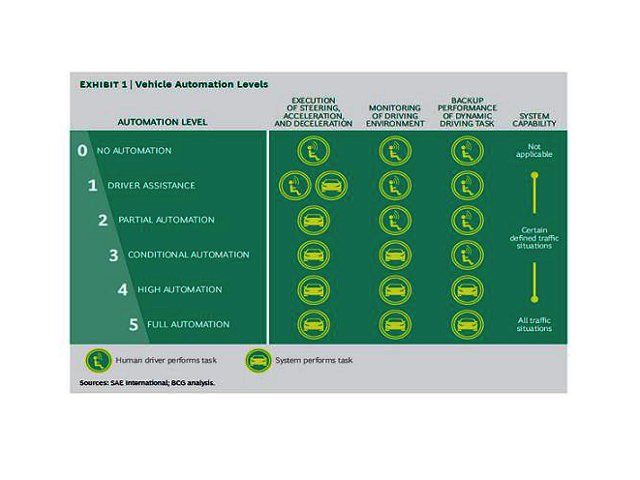The era of the autonomous vehicle (AV) is fast approaching. Mass-market adoption of AVs will be the greatest inflection point for the automotive industry since the introduction of the assembly line and will confer tremendous benefits on society, according to a new report from The Boston Consulting Group (BCG). The report, titled Revolution Versus Regulation: The Make-or-Break Questions About Autonomous Vehicles, is being released today. It is the second in a series of reports, following Revolution in the Driver’s Seat: The Road to Autonomous Vehicles.
The advent of AVs also confronts OEMs, suppliers, regulators, infrastructure operators, and the public at large with urgent technical, societal, and regulatory questions that must be addressed before AVs can hit the road. BCG, working in an exclusive collaboration with the World Economic Forum, explores these questions in the report and proposes potential solutions. The report emphasizes that solutions require the close cooperation of all stakeholders, including the public.
It is worth the effort: In the U.S. alone, widespread adoption of AVs could eliminate more than 30,000 road fatalities annually, cut travel time by as much as 40 percent, recover up to 80 billion hours lost to commuting and congestion, and reduce fuel consumption by as much as 40 percent. Those societal benefits could be worth as much as $1.3 trillion in the U.S., according to various studies.
“To accelerate AV adoption, industry players must collaborate to overcome technology challenges—including those involving cybersecurity, high-definition maps, and vehicle-to-vehicle and vehicle-to-infrastructure communication,” said Nikolaus Lang, a BCG senior partner and one of the report’s coauthors. “But there are equally pressing questions about liability, vehicle certification, and regulatory frameworks. Multistakeholder collaboration is key to developing win-win solutions—and to managing the disruption that will inevitably occur as the automotive industry is reshaped before our eyes.”
Consumer education and close work with policy makers are essential
Societal acceptance is crucial to AV adoption. “Consumers are very excited about the promise of AVs yet remain concerned about safety, reliability, and cybersecurity,” said Xavier Mosquet, a BCG senior partner and a coauthor of Revolution in the Driver’s Seat. “A single fatal accident, even one in which the AV is not at fault, could delay AV adoption by a generation or more.” Moreover, affected third parties, such as taxi drivers, could be a source of opposition—just as they have resisted the Uber ride-sharing service’s expansion in Europe.
Policy makers welcome the societal benefits of AVs in theory but have disparate agendas, depending on whether their role is to regulate or to provide services. Regulators, for example, are more cautious, questioning the technology’s viability in real-world settings. “Yet mayors of megacities welcome AVs to address the ever-growing urban mobility,” said Antonella Mei-Pochtler, a BCG senior partner and one of the report’s coauthors. “They see driverless robo-taxis as the mobility provider in the city of the future.” Both groups recognize the fragile public sentiment, which could easily be swayed by those negatively affected by AVs. Thus, OEMs, new entrants, and other players in the AV ecosystem must proactively work with governments to reconcile potential information asymmetries and collaborate closely on pilot programs to demonstrate the viability of AVs.
A new model for cybersecurity
Recent exploits by “white hat” hackers have exposed the vulnerability of automotive systems. Because such cybersecurity threats are impossible to eliminate, AV stakeholders need to focus on managing these risks. They have to collaborate to recognize threat patterns, develop proactive defense strategies, and coordinate responses. “Bug bounty” programs could help by making threat-related information tradable.
Collaborating to produce maps—and keep them current
AVs can tolerate only small differences between their digital maps and the physical world. To make sense of their environment, they depend on high-definition (HD) maps that are accurate within less than ten centimeters. Yet road configurations change frequently, owing to construction and other factors. HD maps must therefore be constantly updated.
V2x communication: the eyes and ears of AVs
As adoption rates for AVs increase, V2x (the collective term for vehicle-to-vehicle and vehicle-to-industry communication technology) will likely become increasingly necessary as a substitute for driver-to-driver visual communication. But stakeholders must collaborate to ensure trustworthy V2x communication, resolve uncertainty over liability, and ensure data privacy.
Regulation: each region has different priorities
Regulatory challenges are vastly different by region:
- International traffic regulations (for example, the Vienna convention) must be adjusted to allow operation of AVs on public roads. Such operation is at present illegal in many jurisdictions.
- Vehicle and technology certification standards must evolve to allow AVs’ market introduction. Current standards in Europe (United Nations Economic Commission for Europe) and elsewhere bar AVs from coming to market.
- In the U.S. and other jurisdictions, the burden of liability for accidents could potentially shift from driver to manufacturer. This transition needs to be managed properly.
Governments and industry need to collaborate to ensure that regulation keeps pace with technology development to avoid undesired delays in AV adoption.
The road ahead
We are confident that OEMs, new entrants, and policy makers will overcome the obstacles discussed in this report. In the interim, pilot programs are under way in several parts of the world—for example, in Singapore. Such pilots benefit all stakeholders—including the public—by helping to understand the benefits and limitations of AVs in real-life settings. Just as important, they generate empirical data for developing new mobility concepts in cities.
To download a copy of the report, please go to www.bcgperspectives.com.





